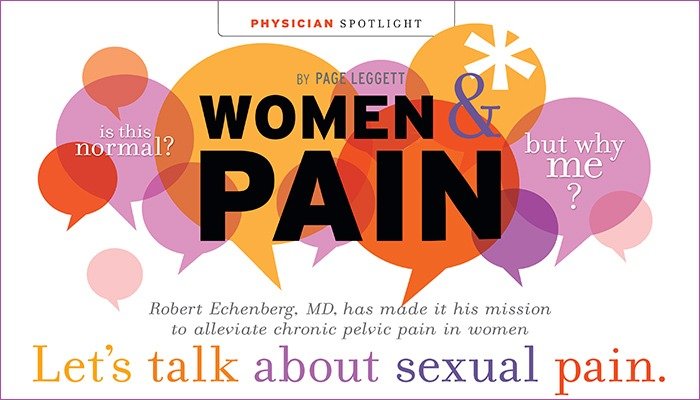Chronic Pelvic Pain

Robert Echenberg, MD, FACOG, an expert in chronic pelvic pain (CPP), wants us — all of us — to feel comfortable talking about a topic that’s often considered taboo. He says even some doctors don’t want to talk about it, although some of their patients are desperate for a way to start a sensitive conversation.
An OB/GYN with more than 35 years of experience, Dr. Echenberg has made educating people about CPP part of his mission. “I want to teach everyone that over 90 percent of chronic pelvic pain results in pain with sexual intimacy, and that sexual function needs to become part of the everyday physician’s vocabulary,” he says.
In other words, we can’t address the problem if we can’t even talk about it.
And given how widespread the problem is, someone needs to get the conversation going. The International Pelvic Pain Society reports that CPP is one of the most common medical problems of reproductive-aged women. Up to 20 percent of the female population between the ages of 18 and 50 may be affected. And a surprising 61 percent of CPP remain misdiagnosed.
Dr. Echenberg believes everyone should be aware of chronic pelvic and genital pain because it is an immense public health problem in the United States. He says it’s estimated that 30 million American women (and unknown numbers of men) suffer from it.
THE ROAD FROM DESPAIR TO HOPE
In 2001, Dr. Echenberg started a pelvic pain program at St. Luke’s Hospital in Bethlehem, Pennsylvania, and practiced both gynecology and pelvic pain management for four years until opening the Institute for Women in Pain in Bethlehem, where he now treats pelvic, genital, and sexual pain exclusively. He also began seeing men who suffer from chronic pelvic and genital pain.
His path to specializing in pelvic pain was born out of need — his patients’ need. “Recognition that so many women were getting multiple invasive diagnostic and therapeutic tests and not improving or finding out true diagnoses” is, he says, what led him to want to help them find relief.
Dr. Echenberg is the sole practitioner at his clinic, which is often the last step in a long journey for patients. According to Dr. Echenberg, “Most of the patients I see have already seen multiple practitioners before seeing us and are commonly angry, frustrated, and skeptical and have resentment and distrust of doctors and the health care system. Some even exhibit anxiety, depression and may have had suicidal thoughts.”
The doctor likes to let patients know his clinic can be their last stop. He intends to find a solution to their pain, and his experience backs up his intention. He estimates he’s treated more than 1,100 women (and a growing number of men) for CPP. “My gratification is seeing even a flicker of hope after the first intake session,” he says. That initial session is thorough; it averages more than three hours. But it’s worth the investment of time, as it’s the first step in what Dr. Echenberg calls the road from despair to hope.
Dr. Echenberg feels called to educate patients and the broader population about CPP. “The first thing a doctor should be is an educator,” he says.
He wants to teach patients and their significant others about how pain is processed in their own bodies. Bu the feels an even larger mission to help spread the word about these conditions that many people are reluctant to discuss, saying that “there really can be an effective, less invasive and much less expensive path to diagnoses and management.”
EXPLAINING THE PAIN
Many women in their reproductive years are undergoing exploratory surgeries that don’t result in any explanation for their pain. Sometimes, reproductive organs are removed and yet their pain is as bad as before surgery, or even worse.
“The incidence of emergency room visits, surgical procedures, expensive invasive testing and admissions to mental health units are all drastically reduced once these diagnoses are made and the patient is cared for in a multidisciplinary, multimodality and multi-organ system model of management,” he says.
There’s much work to be done. Dr. Echenberg aims not just to reach young women and men, but also their partners, teachers, coaches, parents, pediatricians, school nurses, and others. He believes that with education comes an understanding that early treatment of many of these conditions can actually prevent further damage and suffering.
“Pain involving genital structures … should be approached the same way by a professional and a patient as any other part of the body,” he says. The problem is too pervasive to be ignored.
“Chronic genital pain impacts individuals deeply,” Dr. Echenberg says. “Unlike shoulder or knee pain, for instance, this kind of pain involves intimacy, partners, sexual feelings, as well as details of bladder and bowel functioning, all of which may be embarrassing and somewhat taboo subjects to bring up with a professional who generally has no training and no time to help with these disorders.”
Dr. Echenberg has made public pleas for more doc-tors to take up the call. “Too few pelvic practitioners — urologists, gynecologists and GI doctors — are being trained adequately in the assessment and management of CPP and genital pain disorders in their residencies and/or fellowship programs. “The science has exploded in recent years,” he says.“Now it needs to be taught.”
It’s important, Dr. Echenberg says, for people suffering from pelvic pain to seek help as early as possible. Even girls in early adolescence can experience pelvic pain, but their pediatricians may not know to look for it. “Sadly, many doctors are not being taught to diagnose these pelvic pain conditions,” Dr. Echenberg says. If patients aren’t getting relief, he advises them to seek second and third opinions if necessary.
According to Dr. Echenberg, patients should be aware of the psychological toll this kind of physical pain can take. He points to “secondary but often severe emotional diagnoses such as depression, anxiety, frustration, anger and increasing loss of self.”
A HISTORY OF COMPASSION
As the son of a family practice doctor, Dr. Echenberg never dreamed of being anything other than a physician. “I graduated medical school 49 years ago,” he says. He says he can’t imagine any other life or career than the one he has.
Doctoring — and grassroots organizing dedicated to furthering his mission — takes up most of his time these days. He says, only half-jokingly, that in his rare spare time, he eats and sleeps. And that’s about it.
His compassion for his patients comes from a very personal place. “My mother’s sudden death of a hemorrhagic stroke when I was in college led to increasing interests in attachment and loss later on,” he confides.“I was an only child but learned about the stillbirth of my full-term sister exactly a year before my own birth. My aunt told me about my sister only much later on in my teens; it was a family secret. I learned even later that my grandmother lit a candle every year for 50 years for that newborn whom I never knew.”
It may have been that loss — both the one he was aware of and the one he could only sense — that shaped his ideas about motherhood. “I became extremely involved in supporting Lamaze childbirth and in helping, women and families have the best pregnancy and childbirth experience possible,” he says. “I helped establish birthing rooms, midwifery, mother-child bonding, one of the only support groups for parents grieving the loss of miscarriage and stillbirth, and later I began one of the first perinatal ethics committees in the country to assist parents in their decision-making about their seriously ill or terminal newborns.
“I have always wanted to establish organized help for women and families in grief and loss,” he says. “I find that all of that experience and interest has served me well in caring for women in chronic pain. I always thought that nothing would ever exceed the pleasure of being part of the normal, healthy birthing of babies, but I actually think I have more satisfaction no-win helping people cope and manage pain and suffering they thought they would have to live with forever.”
FINDING RELIEF
Dr. Echenberg’s clinic offers several treatments he feels should be standard but are unusual — techniques such as peripheral nerve blocks; trigger point injections throughout the pelvic region, including intravaginal if needed; bladder instillation treatments for interstitial cystitis; and Botox injections into the pelvic floor.
“We work closely with specialized pelvic floor physical therapists, mind/body relaxation therapies, and counseling,” he says. “Ideally, all of this should be available under the same roof, but that’s difficult to provide in today’s climate of reimbursement.”
At 74, an age when most people have retired or are at least contemplating it, Dr. Echenberg is not slowing down.“I do need more rest and relaxation,” he admits, “and there’s more I want to do, like playing violin again and having more time to read, write and teach more.”
As co-author of the book Secret Suffering: How Women’s Sexual and Pelvic Pain Affects Their Relationships, Dr. Echenberg feels that he has another book in him and hopes to find a co-author and collaborator.
Until then, he’ll just keep talking about pelvic, genital, and sexual pain — and encouraging the rest of us to do the same.
Dr. Echenberg says, “Patients and I are partners in this process. Listening, learning, treating, collaborating and comforting; our office is often described as a safe haven by many of our patients.”
Dr. Echenberg has been practicing medicine for most of his life. He finished his undergraduate work at Brown University in 1961, medical training at Jefferson Medical College in 1965, and his residency in obstetrics and gynecology at the University of Michigan in 1970 before serving two years in the military in Bangkok, Thailand.
While he has a blue-chip background, his career hasn’t followed a traditional path, and Dr. Echenberg has been willing to buck the establishment. At 74, he still does. “I love grassroots projects,” he says. “It’s hard to catch the attention of the medical establishment regarding women’s health issues in more conventional ways.”
When he first started out in obstetrics, expectant fathers weren’t even allowed in the delivery room. It struck him as strange that a dad couldn’t witness the birth of his own baby — or be there to help coach the mother of his child through delivery. He also puzzled over women being under such heavy sedation during childbirth.“
In the 1960s and ’70s, women’s issues were exploding,” he says. “I remember seeing women who would literally handcuff themselves to their husbands so they wouldn’t be separated during childbirth.”
Dr. Echenberg took note and began trying to get his hospital’s administration to take notice. “It takes a long time to make that kind of change,” he says. “It took about five years before the hospital changed its policy and allowed fathers in the delivery room.”
But he takes little credit. “It was the women leading the way,” he says.“The only reason there was a change was that these women at the grassroots level demanded that things be different.” He thinks women are going to ultimately demand change in the way CPP is diagnosed and treated.
But he does all he can to sound the call. He was recently a guest speaker at a CPP community awareness program at Commonwealth Medical College in Scranton, Pennsylvania, put together by a high school senior who is a patient.
And there’s more to come. He’ll chair aboard for a newly developing patient support nonprofit organization, Bridge for Pelvic Pain, based in Colorado. And he worked on a forthcoming two-DVD set called Healing the Pain Down There, expected to be released later this year.
His message in all his grassroots work: “Don’t be shy or secretive about these issues. You may have to force your doctor to listen.” {PP}
PainPathways Magazine
PainPathways is the first, only and ultimate pain magazine. First published in spring 2008, PainPathways is the culmination of the vision of Richard L. Rauck, MD, to provide a shared resource for people living with and caring for others in pain. This quarterly resource not only provides in-depth information on current treatments, therapies and research studies but also connects people who live with pain, both personally and professionally.
View All By PainPathways






